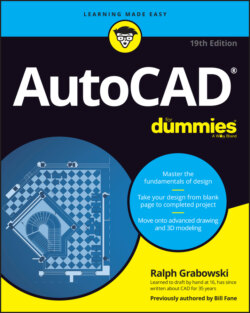Читать книгу AutoCAD For Dummies - Ralph Grabowski - Страница 73
ALTERNATIVES TO THE LINE AND PLINE COMMANDS
ОглавлениеThe Line and PLine commands work well for drawing a series of end-to-end single lines, but you may want to draw a series of double lines to represent, for example, the edges of a wall or roadway. Here are some options:
Use the AutoCAD MLine command to draw multilines, which are a series of two or more parallel straight lines. The AutoCAD Multiline feature was full of limitations when it debuted way back in 1994 (in the notorious Release 13), and despite minor tweaks in AutoCAD 2006, it hasn’t improved significantly since then. It exists mostly for compatibility with MicroStation files. Look up the MLine and MLStyle commands in the AutoCAD online help system if you want to tangle with this feature, but be prepared to spend time experimenting, struggling, and (possibly) cursing. Don’t let small children near you.
Use the PLine command to draw a single set of connected line or arc segments or both, and then use the OFFset command (described in Chapter 11) to create one or more sets of parallel segments.
In AutoCAD LT only, use the DLine, or Double Line, command to draw pairs of parallel line or arc segments or both. Unlike MLine, DLine works well. AutoCAD LT doesn’t have the MLine command, which is more of a blessing than a limitation. AutoCAD, on the other hand, doesn’t have the DLine command. (Score one for the little brother!)
Curved segments in polylines are circular arcs that you can create while running the PLine command. AutoCAD can draw other kinds of curves, including ellipses and splines, but not in the PLine command.
To draw a polyline that includes curved segments, follow these steps:
1 Repeat Steps 1–4 in the preceding step list.
2 To add one or more arc segments, type A, and then press Enter to select the Arc option.The prompt changes to show options for drawing arc segments. Most of these options correspond to the many ways of drawing circular arcs in AutoCAD; see the section on arcs in Chapter 7. The command line shows:Specify endpoint of arc or [Angle CEnter/CLose Direction Halfwidth Line Radius Second pt Undo Width]:
3 Specify the endpoint of the arc by clicking a point or typing coordinates.AutoCAD draws the curved segment of the polyline. The prompts continue to show arc segment options.Specify endpoint of arc or [Angle CEnter/CLose Direction Halfwidth Line Radius Second pt Undo Width]:The options at this point are toSpecify additional points to draw more arc segments.Choose another arc-drawing method, such as CEnter or Second point.Return to drawing straight-line segments with the Line option.In this example, you draw straight-line segments. Perhaps the most useful of the alternative arc-drawing methods is Second pt. It gives you more control over the direction of the arc but at the cost of losing tangency of adjacent segments. (Sometimes, it’s best not to go off on a tangent, anyway.) If you want both ends of the arc segments to be tangent to the adjacent line segments, draw the polyline as straight-line segments and then use the Fillet command (described in Chapter 11) to add the arcs later.
4 Type L and then press Enter to select the Line option.The prompt reverts to showing straight-line segment options.Specify next point or [Arc Close Halfwidth Length Undo Width]:
5 Specify additional points by clicking or typing.
6 After you’re finished drawing segments, either press Enter or type C and press Enter.
Figure 6-3 shows some elements you can draw with the PLine command by using straight segments, arc segments, varying-width segments, or a combination of all of them.
FIGURE 6-3: A plethora of polylines.
